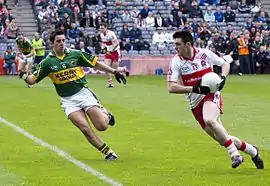Gaelic games
Gaelic games are sports played in Ireland under the auspices of the Gaelic Athletic Association (GAA). They include Gaelic football, hurling, Gaelic handball and rounders. Women's versions of hurling and football are also played: camogie, organised by the Camogie Association of Ireland, and ladies' Gaelic football, organised by the Ladies' Gaelic Football Association. While women's versions are not organised by the GAA (with the exception of handball, where men's and women's handball competitions are both organised by the GAA Handball organisation), they are closely associated with it.[1]

Gaelic games are Ireland's most popular sports, ahead of rugby union and association football.[2] Almost a million people (977,723) attended 45 GAA senior championships games in 2017 (up 29% in hurling and 22% in football on 2016 figures) combined with attendances at other championship and league games generating gate receipts of €34,391,635.[3]
Gaelic football

Gaelic football is played by teams of 15 on a rectangular grass pitch with H-shaped goals at each end. The primary object is to score by driving the ball through the goals, which is known as a goal (worth 3 points), or by kicking the ball over the bar, which is known as a point (worth 1 point). The team with the highest point score at the end of the match wins.[4] The female version of the game is known as ladies' Gaelic football and is similar to the men's game with a few minor rule changes.[5] Other formats with teams of 7 to 11 players are played in Europe,[6] Middle East, Asia, Argentina and South Africa utilising smaller soccer or rugby pitches .
Hurling
.jpg.webp)
Hurling is a stick and ball game played by teams of 15 on a rectangular grass pitch with H-shaped goals at each end. The primary object is to score by driving the ball through the goals or putting the ball over the bar and thereby scoring a point. Three points is the equivalent of a goal. The team with the highest score at the end of the match wins. It is over three thousand years old, and is said to be the world's fastest field game, combining skills from lacrosse, field hockey, and baseball in a hard-hitting, highly skilled game.[7] The female version of the game is known as camogie and is very similar to hurling with a few minor rule changes.[8] Other formats with teams of 7 to 11 players are played in Europe,[6] Middle East, Asia, Argentina and South Africa utilising smaller soccer or rugby pitches.
Gaelic handball
Gaelic handball is a game in which two players use their hands to return a ball against a wall. The game is similar to American handball. There are four codes of handball: Softball (also known as '60x30' or 'big alley' due to the playing court dimensions), 4-Wall (also known as '40x20' or 'small alley'), 1-Wall and Hardball (can also be known as '60x30'; played in the same court as Softball). 1-Wall handball is the most popular international version of handball with it being played in over 30 countries. The sport's governing body, GAA Handball, oversees and promotes the game in Ireland.[9]
Rounders
Rounders is a bat and ball game which is played in Ireland; a similar version is played in the UK. Rounders is organised by a subdivision of the GAA known as the Rounders Council of Ireland. It is similar to the American game softball.[10]
Other Gaelic games
Other Gaelic games such as Gaelic athletics have nearly or completely died out. When founded the GAA organised a number of Gaelic athletics competitions but passed the responsibility to the National Athletic and Cycling Association in 1922. Tailteann Games with Gaelic athletics were held until 1932.[11]
References
- Moran, Mary (2011). A Game of Our Own: The History of Camogie. Dublin, Ireland: Cumann Camógaíochta. ISBN 1908591005.
- "Gaelic games remains Ireland's most popular sport". RTÉ Sport. 26 January 2021.
- "GAA gate receipts up 13%, annual revenue up €5m and attendances increase by 24%". the42.ie. 31 January 2018.
- "Football". GAA.ie. Archived from the original on 5 July 2014.
- "Football for Ladies". GAA.ie. Archived from the original on 16 May 2014.
- "Gaelic Games Europe | Gaelic Athletic Association". Gaelic Games Europe. Retrieved 12 March 2018.
- "Hurling". GAA.ie. Archived from the original on 5 July 2014.
- "Camogie". GAA.ie. Archived from the original on 1 June 2014.
- "Handball". GAA.ie. Archived from the original on 26 June 2014.
- "Rounders". GAA.ie. Archived from the original on 26 June 2014.
- "Athletic Ireland". Retrieved 23 August 2012.
External links
- Official website of the Gaelic Athletic Association (GAA)